Monthly economic brief: December 2020
The monthly economic brief provides a summary of latest key economic statistics, forecasts and analysis on the Scottish economy.
This document is part of a collection
Consumption
Consumer sentiment and consumption activity have been significantly impacted in 2020 by the coronavirus pandemic and restrictions on activity impacting both supply and demand.
Consumer sentiment
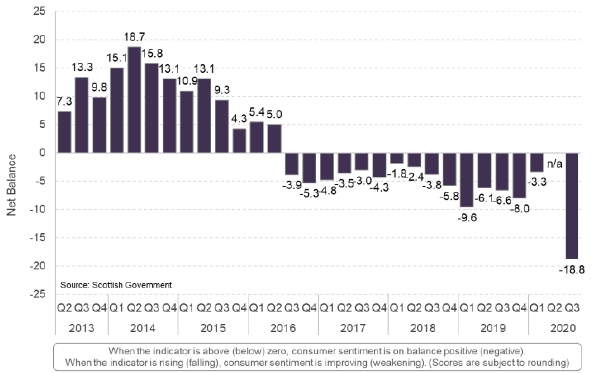
- In Q3 2020, the Scottish Consumer Sentiment Indicator stood at -18.8, indicating that consumer sentiment was on balance negative and at its lowest point in the quarterly time series.[18]
- The low level of consumer sentiment in Q3 was driven by sentiment regarding the current performance of the economy, current security of household finances and current relaxedness about spending being at their lowest levels in the time series, and is reflective of the unprecedented scale of the economic shock during the pandemic.
- Looking ahead to the next 12 months, respondents expectations about the economy and their household finances have been less negatively impacted, and on balance expect them to be performing better in a year’s time than now.
- More recent GfK UK consumer sentiment data[19] for December showed that while overall sentiment remained subdued, households expectations for the economy and their personal financial situation over the coming year strengthened notably over the month as the UK approved use of a vaccine.
- However, there is significant uncertainty for the economic outlook, household expectations, and how they feed through to consumer behaviour. Sentiment indicators will likely continue to be highly sensitive to the rapidly moving developments on the pandemic and the introduction of new restrictions that are required to contain it.
Retail sales
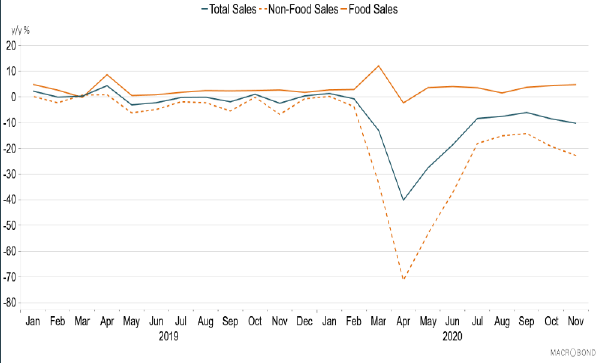
- The Scottish Retail Sales Monitor for November[20] showed that the recovery in retail sales weakened in November, as the move of 11 Local Authorities to Level 4 restrictions for 3-weeks resulted in the closure of non-essential retail.
- The value of total retail sales fell 10.2% over the year to November, its sharpest annual fall since June. While food sales increased by 4.7% (strengthening from 4.4% annual growth in October), non-food retail sales fell 22.8% (down from a 19% fall in October).
- The combination of the closure of non-essential retail across 11 Local Authorities in November, alongside pressure on incomes, subdued sentiment and heightened uncertainty are factors continuing to impact on consumer activity.
Interest rate and inflation
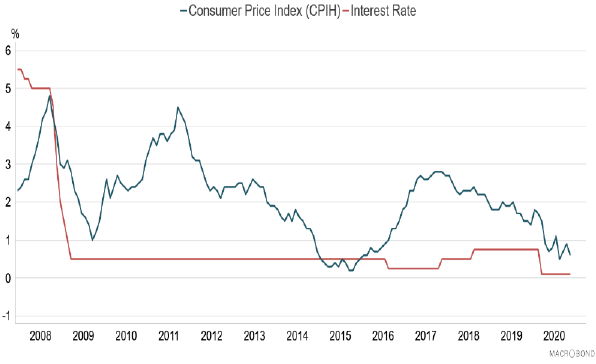
- The fall in demand during national lockdown, alongside the fall in oil price to record lows placed downward pressure on inflation in the first half of 2020 and which has continued into the third and fourth quarters of the year.
- The Consumer Prices Index including owner occupiers’ housing costs (CPIH) 12-month inflation rate fell to 0.6% in November, down from 0.9% in October.[21]
- There were upward contributions to the inflation rate from goods, toys and hobbies categories, however this was more than offset by falling prices for clothing, food and non-alcoholic beverages.
- The Bank of England maintained the Bank Rate at 0.1% in December 2020[22] and in their current central scenario analysis project inflation to fall to 0.5% in 2020 before rising to 2% in 2021.
Updated Medium Term Economic Outlook
Although the availability of a vaccine and the beginning of the roll out of a vaccination programme creates more optimism for the medium term economic outlook, significant uncertainties still remain and the speed of any economic recovery has a number of headwinds to overcome.
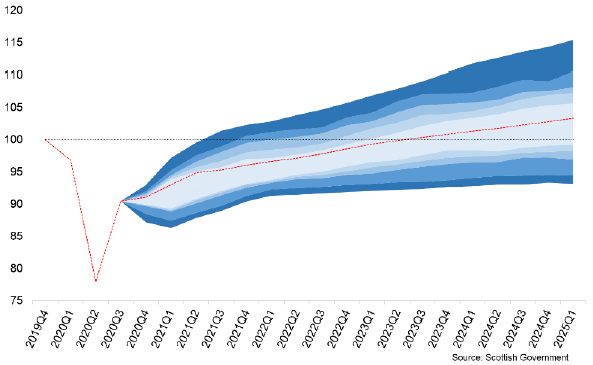
| 2020 | 2021 | |
|---|---|---|
| Annual GDP Growth (%) | -10.8% | 6.4% |
First, until the vaccination programme has reached a significant proportion of the population, restrictions will remain the primary tool with which to suppress the virus. During a significant part of quarter 4 2020, both across the UK and internationally, more stringent restrictions have been in place to tackle a second wave of infections. These restrictions are likely to continue in some form into quarter 1 of 2021.
Second, the transition period with the EU will come to an end on 31 December. At the time of writing there is still no confirmation whether the UK will agree a new trade agreement with the EU, or will move to trading on World Trade Organisation terms.
Conditional on these uncertainties, the first chart outlines the latest central scenario analysis on the medium term outlook for the Scottish economy. The central outlook reflects an outcome where it takes time for the economy to recover from the unprecedented size of the economic shock. As a result GDP may not recover to pre-crisis levels until 2023. We assume that restrictions are gradually relaxed over the first half of 2021, as a vaccine or other measures limit the spread of the virus.
There remain significant uncertainties around the central scenario. On the upside, a much quicker roll out of a vaccination programme could allow most, if not all, restrictions to be lifted quicker as well as help minimise the degree of permanent economic damage. This could see the economy return to pre-crisis levels earlier than in 2023.
However, there remain also a number of downside risks. First, leaving the EU without a trade deal is expected to result in a short-term fall in GDP, depending on the level of disruption that occurs at the UK-EU border. Secondly, a slow or ineffective vaccination programme could lead to the persistence of restrictions in some form for a longer period of time in 2021.
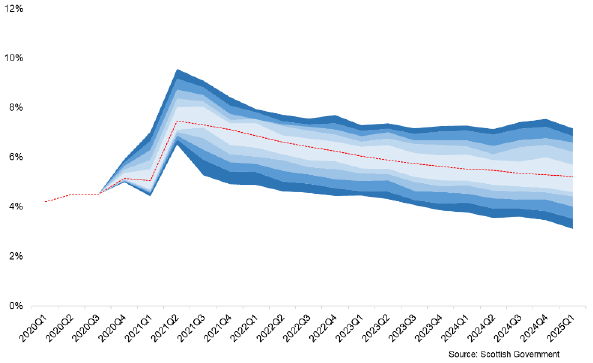
| 2021 | |||
|---|---|---|---|
| Q1 | Q2 | Q3 | |
| Unemployment rate (%) | 5.1% | 7.5% | 7.3% |
The second chart also shows the central outlook on unemployment accompanied by an uncertainty fan chart. In the short term, the furlough scheme, which has been extended for an additional month until the end of April 2021, continues to limit the increase in headline unemployment. Consequently, unemployment is now not expected to begin to rise until Q2 2021.
As with GDP, there remains a significant amount of uncertainty over the medium term outlook for the labour market. Our central scenario still assumes that the labour market will take a relatively long period to recover from the economic shock, in line with historical labour market evidence from other recessions.
However, the role of the furlough scheme in sustaining pre-pandemic jobs mean that the recovery could be much quicker, with people returning quickly to their previous employments, or potentially slower, if it delays people finding new positions.
Overall, in the central scenario Scotland’s GDP falls 10.8% in 2020 before growing 6.4% in 2021 and gradually returns to pre-pandemic levels in 2023, while unemployment rises to 7.5% in Q2 2021 before gradually easing back.
Contact
Email: OCEABusiness@gov.scot
There is a problem
Thanks for your feedback